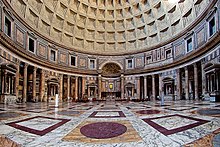Pavonazzo marble

Pavonazzo marble, also known as Pavonazzetto, Docimaean marble or Synnadic marble,[1] is a whitish marble originally from Docimium, or modern İscehisar, Turkey.[2][3]
Etymology
The name derives from the Italian word for
History
Ancient world

Pavonazzetto was not widely or extensively used before the Roman period; there is no evidence of it in circulation before the last two decades BC.
Docimian Pavonazzetto was extensively used in major building projects both within Rome and the rest of the empire. Pavonazzetto was used on the most eye catching places such as, columns, wall and floor veneer and wall reliefs. Other marbles from all corners of the empire were used in combination; whenever Pavonazzetto was used as floor cover, it was usually in combination with other decorative marbles, however, the Pavonazzetto being a primarily white marble, it gave buildings a freshening white color.
Docimian marble was also preferred for sarcophagi sculpting, many emperors preferring this marble for its high value and majestic looks. As a result, some of the greatest masterpieces were made from this material, including the sarcophagi of Eudocia, Heraclius and many more.[5]
Later Use
Docimaean Pavonazzo was later used for the Memoria Petri, the
List of buildings with Pavonazzo marble
Buildings in Rome
- The Pantheon contains Docimian Pavonazzetto as floor pavement along with other marble types.[6][7] The dominant white color is the Pavonazzetto, also some of the interior main columns and pilasters are made from Docimian marble.[8]
- Forum of Augustus[9]
- Temple of Mars Ultor (floor)[13]
- Temple of Apollo (floor)[14]
- Basilica Aemelia (20 statues)[15][16]
- Basilica Julia (floor and some columns)[17][18]
- Basilica Ulpia (some of the columns)[19]
- Basilica of San Paolo fuori le Mura (24 columns, destroyed by fire in 1823)[20]
- The eight statues on the Arch of Constantine[21]
- Baths of Caracalla (some of the columns and wall veneer)[22][23]
Buildings outside of Rome
- The Hagia Sophia has Docimian marble as veneer on the aisles and galleries.[24]
- Saint Peter's Basilica, as veneer.[25]
- Leptis Magna, former limestone columns were replaced with Pavonazzetto.[26]
- Library of Celsus, the columns on the famous wall.[27]
- Ancient City of Sagalassos, as wall and floor covering, 40 tons of veneer were recovered.[28][29]
- Temple of Zeus and Hera in Greece, 100 columns and wall.[30]
See also
References
- ^ Strabo. Geography. "Book 9, chapter 5, section 16"
- ISBN 9781443873505.
- ISBN 9780190266875.
- ^ Matthias Bruno, et al. “The Docimium Marble Sculptures of the Grotto of Tiberius at Sperlonga.” American Journal of Archaeology, vol. 119, no. 3, 2015, pp. 375–394.
- ISBN 9788882653781.
- ISBN 9780674035720.
- ISBN 9780674010192.
- ISBN 9780860546191.
- ISBN 9781611173369.
- ISBN 9781782127970.chapter, ROME: CROSSING CONTINENTS
- ISBN 9780520226739.
- ISBN 9780199656394.
- ISBN 9780521810685.
- ISBN 9780521810685.
- ISBN 9782867812446.
- ISBN 9780521192446.
- ISBN 9780292767423.
- ISBN 9780860546191.
- ISBN 9780801843006.
- ISBN 9789004302075.
- ISBN 9780199656394.
- ISBN 9781887829250.
- ^ Dante Giuliano Bartoli (2008). Marble Transport in the Time of the Severans, Texas University (PDF). p. 154. Archived (PDF) from the original on 2022-10-09.
- ISBN 9781317124153.
- ISBN 9780674069060.
- ISBN 9780199656394.
- ISBN 9781118886090.
- ^ Abu Jaber; N. Bloxam. QuarryScapes, Geological Survey of Norway (PDF). p. 102. Archived (PDF) from the original on 2022-10-09.
- ISBN 9789058670793.
- ^ Pausanias. Book 1 Attica 16-29, Athens. Book, 1,18,9
